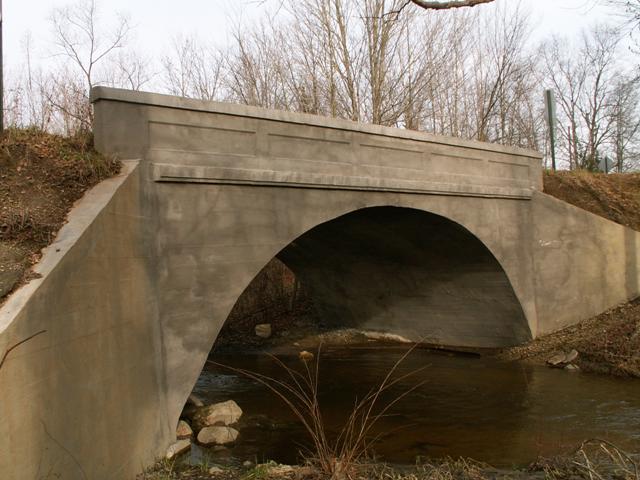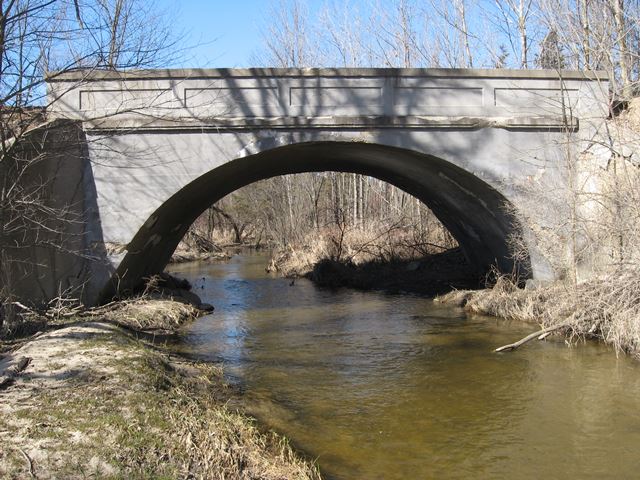We Recommend:
Bach Steel - Experts at historic truss bridge restoration.
BridgeHunter.com Phase 1 is released to the public! - Visit Now
Burt Road Bridge

Primary Photographer(s): Nathan Holth
Bridge Documented: July 1, 2006 and November 6, 2021
Rural: Hillsdale County, Michigan: United States
1918 By Builder/Contractor: Beighton and Spaulding of Pioneer, Ohio and Engineer/Design: Michigan State Highway Department
2005
30.8 Feet (9.4 Meters)
35.8 Feet (10.9 Meters)
20 Feet (6.1 Meters)
1 Main Span(s)
30322H00007B010

View Information About HSR Ratings
Bridge Documentation
Unlike the demolished and nearly identical Watervliet Road Bridge, this bridge in Hillsdale County has been preserved, with concrete patching and sealing. The work was done in 2005 by Albright Contractors who call themselves "The Bridge Doctors" and specialize in repairs. The work done on the bridge respected the original designs of the structure. As a result, perhaps this historic structure, the last historic concrete arch bridge in Hillsdale County, can remain for people to enjoy for many years to come. It is an important example of early trunk line bridge construction, and is an attractive structure as well. Located on a very rural dirt road, it might come as a surprise that this bridge was built as a trunkline bridge. Some of the early trunkline bridges were not as elaborate as the larger highways constructed in later years. As with this bridge, Burt Road was really just a normal road aligned to the grid that the MSHD simply improved a bit and put signage up for.
View Archived National Bridge Inventory Report - Has Additional Details and Evaluation
Information and Findings From Michigan Historic Bridge InventoryNarrative Description
An 1894 atlas shows a thoroughfare following the present route of Burt Road, presumably carried across Silver Creek by a previous structure. At the time of the present bridge's construction, this unpaved section of Burt Road formed part of State Highway No. 308, which ran east-west. Identified by the bridge plate as Trunk Line Bridge No. 237, the structure was built by the state highway department during Frank F. Rogers's term as commissioner. The plate also names Beighton and Spaulding, a company based in Pioneer, Ohio, as the contractor. The bridge's design is apparently based upon the highway department's standardized plan for reinforced concrete arches, which was presented in the department's 1914 Fifth Biennial Report. The 1916 report contains a photograph of a similar 40-foot span in Berrien County, the North Watervliet Road Bridge, which is still extant and is also eligible for the National Register. Statement of Significance Trunk Line Bridge No. 237 is eligible for the National Register as a well-preserved, early example of a concrete-arch bridge built according to a state highway department standard plan. |
This bridge is tagged with the following special condition(s): Unorganized Photos
![]()
Photo Galleries and Videos: Burt Road Bridge
Bridge Photo-Documentation
A collection of overview and detail photos. This photo gallery contains a combination of Original Size photos and Mobile Optimized photos in a touch-friendly popup viewer.Alternatively, Browse Without Using Viewer
![]()
Additional Unorganized Photos
Original / Full Size PhotosA supplemental collection of photos that are from additional visit(s) to the bridge and have not been organized or captioned. This gallery offers photos in the highest available resolution and file size in a touch-friendly popup viewer.
Alternatively, Browse Without Using Viewer
![]()
Additional Unorganized Photos
Mobile Optimized PhotosA supplemental collection of photos that are from additional visit(s) to the bridge and have not been organized or captioned. This gallery features data-friendly, fast-loading photos in a touch-friendly popup viewer.
Alternatively, Browse Without Using Viewer
![]()
Maps and Links: Burt Road Bridge
Coordinates (Latitude, Longitude):
Search For Additional Bridge Listings:
Bridgehunter.com: View listed bridges within 0.5 miles (0.8 kilometers) of this bridge.
Bridgehunter.com: View listed bridges within 10 miles (16 kilometers) of this bridge.
Additional Maps:
Google Streetview (If Available)
GeoHack (Additional Links and Coordinates)
Apple Maps (Via DuckDuckGo Search)
Apple Maps (Apple devices only)
Android: Open Location In Your Map or GPS App
Flickr Gallery (Find Nearby Photos)
Wikimedia Commons (Find Nearby Photos)
Directions Via Sygic For Android
Directions Via Sygic For iOS and Android Dolphin Browser
USGS National Map (United States Only)
Historical USGS Topo Maps (United States Only)
Historic Aerials (United States Only)
CalTopo Maps (United States Only)



